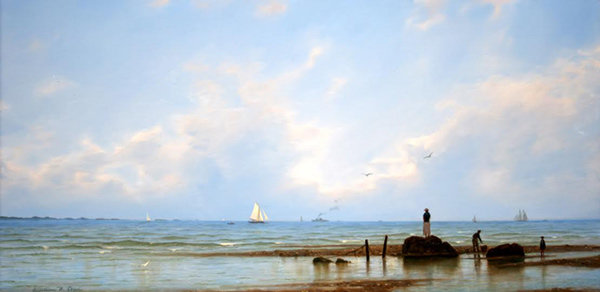While his maritime subjects are inspired by his childhood experiences exploring the islands about Lewis Bay, admirers and collectors have come to covet William Davis’s mastery of luminosity and light.
It is hard to believe that William R. Davis is a self-taught painter. His pictures breathe with life, character, and light that seem possible only for a well-trained painter. That’s what 38 years of full-time trial and error can accomplish, and Davis is still excelling in ways that continue to captivate.
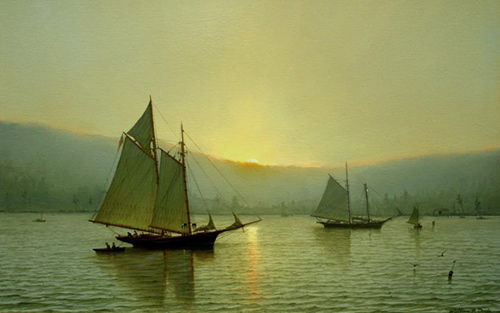
William R. Davis, “Safe Anchor, Southwest Harbor,” 2012, oil on canvas, 24 x 36 in. (c) William R. Davis 2015
Davis is among the world’s most renowned maritime painters, and, like so many before him, his journey to become an artist began early in life. “The inspiration certainly comes from my childhood,” says Davis. “I filled my days playing along the shores of Hyannis Port, Massachusetts, a wonderful place to grow up. By 10 years old, I was sailing single-handed small catboats, exploring every small island and cove in and about Lewis Bay.” The young Davis developed an acute and discerning eye for light as it cascades across the waters, a realist observation that surfaces in all his work. “Sailing also gave me the self-confidence and patience in developing my skills,” he notes.
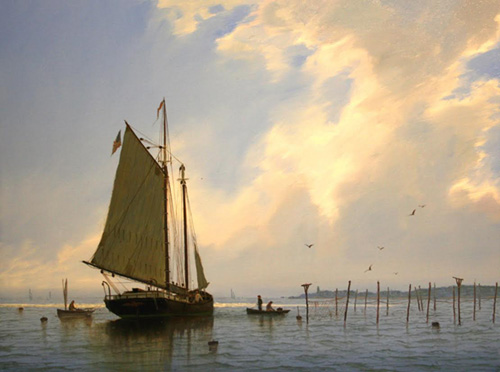
William R. Davis, “Weir Fishermen off West Dennis Beach,” 2014, oil on panel, 12 x 16 in. (c) William R. Davis 2015
Davis’s process often begins with painting the scene’s sky from top to bottom, which allows the artist to match the water’s reflective colors exactly. Broad and simplified details above the horizon are imaged and blended in the wet paint before the piece is allowed to dry. Details slowly begin to emerge after this point, when Davis begins to outline his wooden boats and other elements in the landscape. The final process involves adding details in the water and boats and highlighting points of highest luminosity.
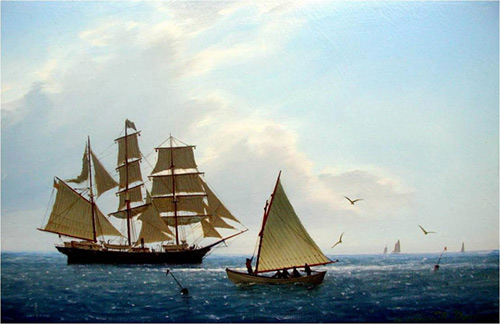
William R. Davis, “Raising the Peak,” 2009, oil on panel, 8 x 12 in. (c) William R. Davis 2015
Particularly lovely about Davis’s paintings is their nostalgic allure, with most pictures depicting the traditional wooden sailboats that are nearly impossible to find since the introduction of fiberglass. This is an important element for Davis, who, along with his collectors and admirers, longs to see harbors populated with the elegant and character-filled vessels. Inspired by artists of the Hudson River School in addition to such masters as Edward Moran, Antonio Jacobsen, and Fitz Henry Lane, Davis’s paintings have a level of detail, quietness, and glow that is timeless. Indeed, it is the inner glow and radiance of his paintings that has harnessed the most attention.
“My customers have always expressed their enjoyment at having my works hanging in their homes,” says the artist. “Even many years later, I’m approached by people who want to tell me how the light changes on their painting several times a day. What I take away from this is a satisfaction from producing something that people love and want to live with.”
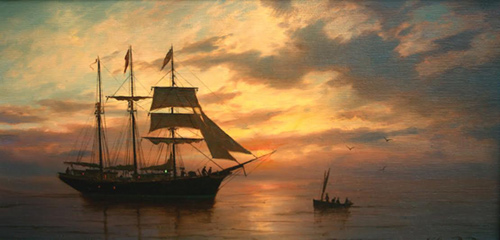
William R. Davis, “The Rendezvous,” 2013, oil on canvas, 10 x 16 in. (c) William R. Davis 2015
Who wouldn’t want “Weir Fishermen off West Dennis Beach” adorning their home? Albeit small, the painting packs a significant impact. Calmly resting in center left is a beautiful vessel, its sails extended as they are silhouetted against the waning light of the sky. “Distant Ships” is another outstanding picture, itself having an old-time tone as the boats glide across the horizon. “Safe Anchor, Southwest Harbor” has a greenish glow to its light, in some ways giving the piece an aged appearance.

William R. Davis, “Light Snow over the Marsh,” 2015, oil on panel, 12 x 24 in. (c) William R. Davis 2015
The future is exciting for Davis, who seeks to expand the scale of his paintings, which have remained relatively small throughout his career. “The most important effort has been increasing the size of my paintings and maintaining the same luminosity and color on a grand scale,” he says. One can only imagine, if he is successful, the wonders in store.
To learn more, visit William Davis.
This article was featured in Fine Art Today, a weekly e-newsletter from Fine Art Connoisseur magazine. To start receiving Fine Art Today for free, click here.

